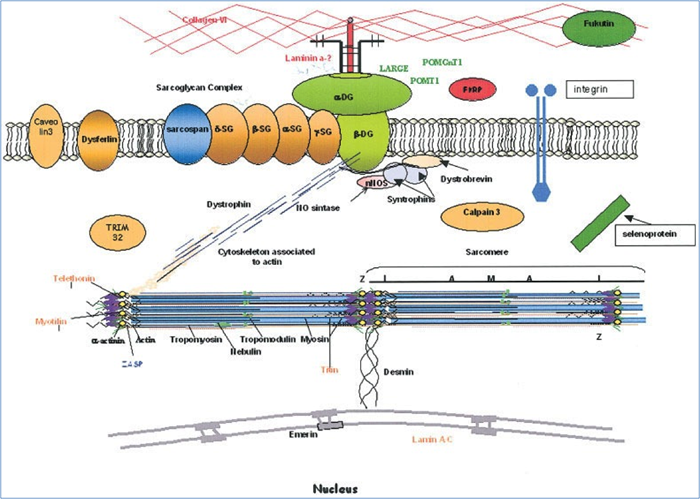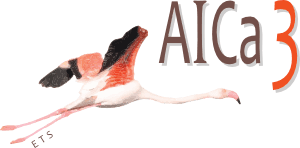The girdle dystrophies (limb-girdle muscular dystrophies - LGMDs) are a heterogeneous group of genetically determined progressive disorders that primarily or predominantly involve the muscles of the cingulate, both pelvic and scapular, whose symptoms occur between approximately five and forty years of age, in both males and females.
Several diseases of different genetic origin are grouped in cingulate dystrophy. Autosomal dominant (LGMD type 1) and recessive (LGMD type 2) transmission types are observed. Dominant forms constitute less than 10% of cases.
AUTOSOMAL DOMINANT FORMS
Disease abbreviation |
Gene |
Altered protein |
| LGMD1A MYOT | Chromosome 5q31 | Mytiline |
| LGMD1B LMNA | Chromosome 1q21 | Lamin A/C |
| LGMD1C CAV3 | Chromosome 3p25 | Caveolin 3 |
| LGMD1D DNAJB6 | Chromosome 7q36 | DNAJB6 |
| LGMD1E Not known | Chromosome 2q35 | Desmin |
| LGMD1F Not known | Chromosome 7q32 | Not known |
| LGMD1G Not known | Chromosome 4q21 | Not known |
| LGMD1H Not known | Chromosome 3q23 | Not known |
AUTOSOMAL RECESSIVE FORMS
Disease abbreviation |
Gene |
Altered protein |
| LGMD2A CAPN3 | Chromosome 15q15 | Calpain 3 |
| LGMD2B DYSF | Chromosome 2p13.2 | Dysferlin |
| LGMD2C SGCGG | Chromosome 13q12 | γ-sarcoglycan |
| LGMD2D SGCGA | Chromosome 17q21.33 | α-sarcoglycan |
| LGMD2E SGCGB | Chromosome 4q12 | β-sarcoglycan |
| LGMD2F SGCGD | Chromosome 5q33 | δ-sarcoglycan |
| LGMD2G TCAP | Chromosome 17q12 | Telethonin |
| LGMD2H TRIM32 | Chromosome 9q33.1 | TRIM32 |
| LGMD2I FKRP | Chromosome 19q13.3 | FKRP |
| LGMD2J TTN | Chromosome 2q24 .3 | Titin |
| LGMD2K POMT1 | Chromosome 9q34.1 | O-mannosil transferase 1 |
| LGMD2L ANO5 | Chromosome 11p13-p12 | Anoctamin |
| LGMD2M FKTN | Chromosome 9q31 | Fukutin |
| LGMD2N POMT2 | Chromosome 14q24 | O-mannosil transferase 2 |
| LGMD2O POMGnt1 | Chromosome 1p34.1 | Mannose β1,2-N- acetylglucosaminyltransferase |
| LGMD2P DAG1 | Chromosome 19q13 | Dystroglycan |

Representation of muscle fiber proteins, red arrow indicates calpain3 (CAPN3)
In the forms with autosomal dominant inheritance, the affected parent has a 50% risk of transmitting the disease to their children, regardless of their sex. For these forms there are no carriers who are completely healthy, while it is possible to find individuals with milder symptoms. The dominant forms (LGMD1A-H, i.e., those transmitted by a DNA alteration present in only one element of the chromosome pair) are usually more benign and relatively rare, accounting for less than 10 percent of all cingulate dystrophies.
In recessive forms, children will develop the disease only if both parents are at least carriers. This risk is greatly increased in case of intermarriage. In all these cases the risk of having sick children is 25% and the risk of having carrier children is 50% per birth.
The prevalence of autosomal recessive transmission and sporadic cases of cingulate muscular dystrophy (LGMD) has been estimated to be 1/150,000- 200,000 with considerable variability in prevalence among different forms of cingulate dystrophy according to different geographical areas. In Italy, for example, approximately 35% of LGMD cases are a clinically and histochemically defined form of LGMD2A. Only 33% of LGMD2A cases are associated with a defined mutation on the calpain 3 gene.
The clinical course is characterized by wide variability, with severe forms with early onset and rapid progression and less severe forms that allow affected individuals an almost normal life expectancy and motor autonomy.
